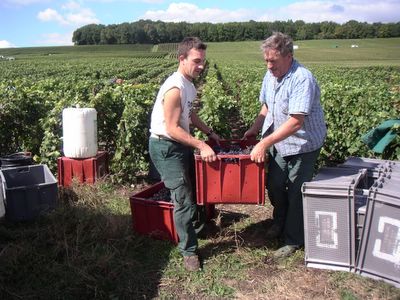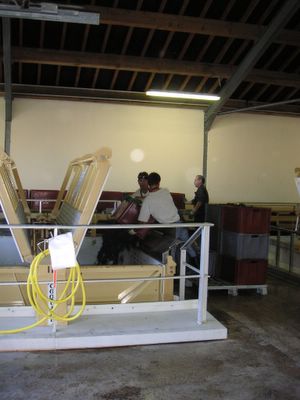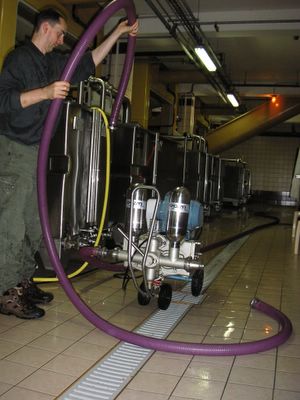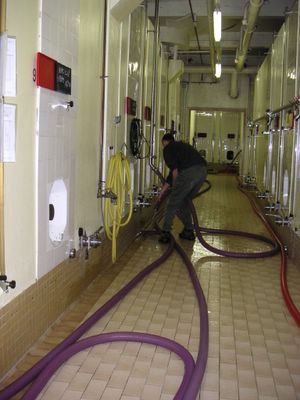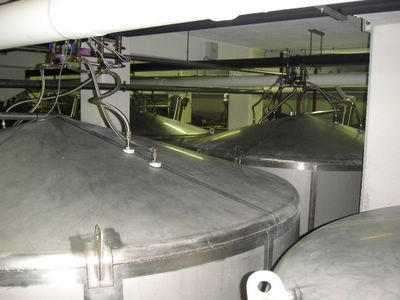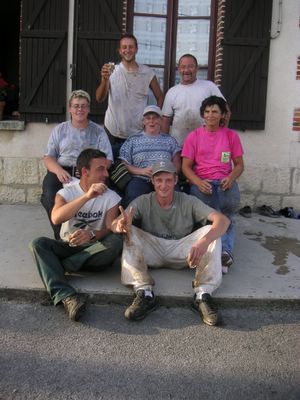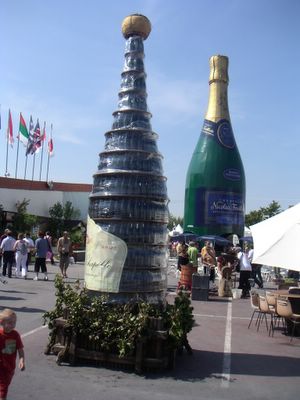 Gipsycamp outside Chigny-les-Roses in Montagne de Reims.
Gipsycamp outside Chigny-les-Roses in Montagne de Reims.The many and scattered camps is back in Champagne. Anywhere outside the villages where there is no wine, you will find gipsy groups with their caravans, tents and clothes lines. They have come to harvest the grapes, and now they just wait to sign up with someone.
The harvest of the grapes start in the Côte des Blancs tomorrow, September 12th. As we today rested after a sundaylunch with the family we could see the gipsies arrive, a caravan of caravans through the mainstreet of the village. They are here on tolerated residence during these few weeks.
Temporary jobmarketSome of the gipsy teams already know where they can stay. That goes for those who already have made a deal with a winegrower last year. A deal, that they keep.
Others just come along. During tomorrow, monday, they will ask here and there until they find jobs during the harvest. Maybe at one of those
vignerons who has either been stood up or just waits until the last minute to hire people. It is these people you will also meet in the roads when their move their long line of caravans from one place to the other in search of work. When they eventually can sign up for something, the employer must provide a room for the caravans with access to water, electricity and toilets.
The local newspaper l'Union works as meeting place for others. On special pages only concerning the harvest of the grapes, the paper lists places to show up and phone numbers to call, so that those who look for jobs can hook up with those who need people. In the paper you can also find the rates for the different jobs. And this is where you find the explanation of why so much of the necessary labour comes from outside the region. The wages are too bad.
Rate per hour or kiloAs picker of grapes and paid per hour I rank in the absolute bottom of everything. The aching muscles that I expect to have gained in no more than one week, is paid with 8,08 euro per hour (appr. 60 Danish crowns). My brother in law, who with a partner empties the 50 kilo boxes of grapes into the press, receives 9,12 euro per hour and on top of that a not yet settled bonus. With a working day of 12-13 hours he will have moved quite some kilos at the end of the day, since each
marc - pressing - contains up to 8.000 kilo of grapes. My husband, who guides the work and monitors the content of the boxes - that is sound berries and no leaves - peaks with 10,23 euro, and on top of that he is definitely the one to have less pains in the body. That is just the way it is. There is always more money in the complete view of transactions rather than detail and speed, and that goes for much more than just the
vendange.
Food and lodging is part of my wages as well. More accurately it adds up to 14,54 euros each day deducted from the amount I make in the fields. Since we work eight hours every day, there is not even 400 Danish crowns left after a full day in the fields. Before taxes that is. But the mealsystem is great: We get so much country style food from early morning and all the way to the last piece of cake just before bedtime and champagne with the meals of course.
The other way of payment is a single price per kilo. People that are paid after these rules normally take care of their own food and lodging. The gipsyfamilies are normally hired in this way. This year the grapes are in general very big, which makes it a lot easier and faster to reach a kilo. Thus payment per kilo -
a la tâche - could be more the more interesting way of payment this year.
Whether a winegrower picks one or the other is sometimes more a question of necessity than anything else. If he cannot provide the minimum requirements, decided by the authorities, such as a certain number of showers for a certain number of people, he may hire some pickers with lodging and others without. This does not necessary mean that those hired
a la tâche will actually have access to a shower. But I suppose, in this case it is regarded as own choice rather than lacking equipment of the employer.
 Our winepickers is mainly family and old contacts.An army of seasonal workers
Our winepickers is mainly family and old contacts.An army of seasonal workersKilorate or timerate: One thing is sure. The
vendange in Champagne has started in the first villages. There is about one month to pick the yields of the year.
It is a job done by around 120.000 seasonal workers. Some of them are gipsies, others are from Eastern Europe and in the last group, living in France, you will find locals, some from other areas and finally a group of foreign students. From the last group Chinese students have shown quite some interest in low-status jobs similar to the picking of the grapes. However, if there actually are Chinese in the rows, I do not know.
Many French are now rather aware, that you do not hire Chinese people for jobs, you do not want to see copied in China later on. But of course you may have to choose between one evil or the other, since the number of thefts is said to rise as the gipsies arrive.
Closed TabacI cannot say how much is rumour and how much is true. But I can see that some people most certainly act on the changes even if it means less income. The woman who runs the local
tabac for instance only sells cigarettes from an almost barricaded shop during the grape harvest, and only to people she already knows. So I have had to go to the next village to get supplies since I did not know about her special practice.
Anway somebody has got to go for the grapes, the Champagne gold, and that provides the gipsies a way of making money. The other solution would be that the winegrowers would raise the salary to a level, where the locals would be interested in the more physical aspects of the wine.
When I watch the number of temporary camps and the amount of garbage on the edge of the ditches, however it does not seem necessary to change anything for a while. I suppose that everybody must be okay with what they have got...
På dansk






